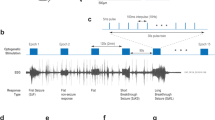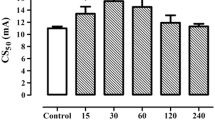Abstract
The 6-hertz (6 Hz) model is an effective tool to screen drugs for psychomotor seizures and/or treatment-resistant focal seizures. It is known to identify the drugs or molecules acting via different mechanisms, unlike the traditional models. Seizure is induced by corneal stimulation (6 Hz, 0.2 ms for 3 s duration) using electroconvulsometer. The characteristic features seen in rodents are stun position and minimal clonic phase, followed by stereotyped behavior observed for 120 s, at stimulus of different intensities like 22, 32, or 44 mA. The animals are considered as protected if no stereotype behavior is observed and the animal resumes normal exploratory behavior within 10 s. Despite being effective in identifying the antiseizure potential of certain drugs possessing newer mechanisms, the model cannot correlate the neuronal and pathophysiological adaptations occurring in chronic cases of epilepsy, which is considered as its drawback.
Access this chapter
Tax calculation will be finalised at checkout
Purchases are for personal use only
Similar content being viewed by others
References
Swinyard EA (1972) Electrically induced seizures. In: Purpura DP, Penry JK, Tower DB, Woodbury DM, Walter RD (eds) Experimental models of epilepsy: a manual for the laboratory worker. Raven Press, New York, pp 433–458
Brown WC, Schiffman DO, Swinyard EA, Goodman LS (1953) Comparative assay of antiepileptic drugs by “psychomotor” seizure test and minimal electroshock threshold test. J Pharmacol Exp Ther 107(3):273–283
Barton ME, Klein BD, Wolf HH, White HS (2001) Pharmacological characterization of the 6Hz psychomotor seizure model of partial epilepsy. Epilepsy Res 47(3):217–227
Metcalf CS, West PJ, Thomson KE, Edwards SF, Smith MD, White HS, Wilcox KS (2017) Development and pharmacologic characterization of the rat 6 Hz model of partial seizures. Epilepsia 58(6):1073–1084
White HS, Bender AS, Swinyard EA (1988) Effect of the selective N-methyl-D-aspartate receptor agonist 3-(2-carboxypiperazin-4-yl)propyl-1-phosphonic acid on [3H] flunitrazepam binding. Eur J Pharmacol 147(1):149–151
Loscher W, Honack D (1993) Profile of UCB L059, a novel anticonvulsant drug, in models of partial and generalized epilepsy in mice and rats. Eur J Pharmacol 232:147–158
Klitgaard H, Matagne A, Gobert J, Wulfert E (1996) Levetiracetam (UCB L059) prevents limbic seizures induced by pilocarpine and kainic acid in rats. Epilepsia 37(S5):118
Leclercq K, Kaminski RM (2015) Status epilepticus induction has prolonged effects on the efficacy of antiepileptic drugs in the 6-Hz seizure model. Epilepsy Behav 49:55–60
Gower AJ, Noyer M, Verloes R, Gobert J, Wülfert E (1992) UCB L059, a novel anti-convulsant drug: pharmacological profile in animals. Eur J Pharmacol 222(2–3):193–203
Leclercq K, Matagne A, Provins L, Klitgaard H, Kaminski RM (2020) Pharmacological profile of the novel antiepileptic drug candidate padsevonil: characterization in rodent seizure and epilepsy models. J Pharmacol Exp Ther 372(1):11–20
Kaminski RM, Livingood MR, Rogawski MA (2004) Allopregnanolone analogs that positively modulate GABAA receptors protect against partial seizures induced by 6-Hz electrical stimulation in mice. Epilepsia 45(7):864–867
Wojda E, Wlaz A, Patsalos PN, Luszczki JJ (2009) Isobolographic characterization of interactions of levetiracetam with the various antiepileptic drugs in the mouse 6 Hz psychomotor seizure model. Epilepsy Res 86(2–3):163–174
Jahan K, Pillai KK, Vohora D (2017) Parachlorophenylalanine-induced 5-HT depletion alters behavioral and brain neurotransmitters levels in 6-Hz psychomotor seizure model in mice. Fundam Clin Pharmacol 31(4):403–410
Racine RJ (1972) Modification of seizure activity by electrical stimulation: II. Motor seizure. Electroencephalogr Clin Neurophysiol 32(3):281–294
Hartman AL, Lyle M, Rogawski MA, Gasior M (2008) Efficacy of the ketogenic diet in the 6-Hz seizure test. Epilepsia 49(2):334–339
Bankstahl M, Bankstahl JP, Löscher W (2013) Pilocarpine-induced epilepsy in mice alters seizure thresholds and the efficacy of antiepileptic drugs in the 6-hertz psychomotor seizure model. Epilepsy Res 107(3):205–216
Rowley NM, White HS (2010) Comparative anticonvulsant efficacy in the corneal kindled mouse model of partial epilepsy: correlation with other seizure and epilepsy models. Epilepsy Res 92(2–3):163–169
Walrave L, Maes K, Coppens J, Bentea E, Van Eeckhaut A, Massie A, Van Liefferinge J, Smolders I (2015) Validation of the 6 Hz refractory seizure mouse model for intracerebroventricularly administered compounds. Epilepsy Res 115:67–72
Freeman J, Veggiotti P, Lanzi G, Tagliabue A, Perucca E (2006) The ketogenic diet: from molecular mechanisms to clinical effects. Epilepsy Res 68(2):145–180
Neal EG, Chaffe H, Schwartz RH, Lawson MS, Edwards N, Fitzsimmons G, Whitney A, Cross JH (2008) The ketogenic diet for the treatment of childhood epilepsy: a randomised controlled trial. Lancet Neurol 7(6):500–506
Giordano C, Marchiò M, Timofeeva E, Biagini G (2014) Neuroactive peptides as putative mediators of antiepileptic ketogenic diets. Front Neurol 29(5):63
Lucchi C, Marchiò M, Caramaschi E, Giordano C, Giordano R, Guerra A, Biagini G (2017) Electrographic changes accompanying recurrent seizures under ketogenic diet treatment. Pharmaceuticals 10(4):82
Leclercq K, Matagne A, Kaminski RM (2014) Low potency and limited efficacy of antiepileptic drugs in the mouse 6 Hz corneal kindling model. Epilepsy Res 108(4):675–683
Albertini G, Walrave L, Demuyser T, Massie A, De Bundel D, Smolders I (2018) 6Hz corneal kindling in mice triggers neurobehavioral comorbidities accompanied by relevant changes in c-Fos immunoreactivity throughout the brain. Epilepsia 59(1):67–78
Giordano C, Vinet J, Curia G, Biagini G (2015) Repeated 6-Hz corneal stimulation progressively increases FosB/ΔFosB levels in the lateral amygdala and induces seizure generalization to the hippocampus. PLoS One 10(11):e0141221
Jahan K, Pillai KK, Vohora D (2019) Serotonergic mechanisms in the 6-Hz psychomotor seizures in mice. Hum Exp Toxicol 38(3):336–346
Jahan K, Pillai KK, Vohora D (2018) DSP-4 induced depletion of brain noradrenaline and increased 6-hertz psychomotor seizure susceptibility in mice is prevented by sodium valproate. Brain Res Bull 142:263–269
Vohora D, Pal SN, Pillai KK (2001) Histamine and selective H3-receptor ligands: a possible role in the mechanism and management of epilepsy. Pharmacol Biochem Behav 68(4):735–741
Fujimoto Y, Funao T, Suehiro K, Takahashi R, Mori T, Nishikawa K (2015) Brain serotonin content regulates the manifestation of tramadol-induced seizures in rats: disparity between tramadol-induced seizure and serotonin syndrome. Anesthesiology 122(1):178–189
Cumper SK, Ahle GM, Liebman LS, Kellner CH (2014) Electroconvulsive therapy (ECT) in Parkinson’s disease: ECS and dopamine enhancement. J ECT 30(2):122–124
Barton ME, Peters SC, Shannon HE (2003) Comparison of the effect of glutamate receptor modulators in the 6 Hz and maximal electroshock seizure models. Epilepsy Res 56(1):17–26
Nakamura J, Mine K, Yamada S (1991) Effects of anticonvulsants on the electroconvulsive threshold lowered by DA, 5-HT or GABA depletion. Kurume Med J 37(4):253–259
Scherkl R, Hashem A, Frey HH (1991) Histamine in brain—its role in regulation of seizure susceptibility. Epilepsy Res 10(2–3):111–118
Jobe PC, Stull RE, Geiger PF (1974) The relative significance of norepinephrine, dopamine and 5-hydroxytryptamine in electroshock seizure in the rat. Neuropharmacology 13(10–11):961–968
Esneault E, Peyon G, Castagné V (2017) Efficacy of anticonvulsant substances in the 6 Hz seizure test: comparison of two rodent species. Epilepsy Res 134:9–15
Metcalf CS, Huff J, Thomson KE, Johnson K, Edwards SF, Wilcox KS (2019) Evaluation of antiseizure drug efficacy and tolerability in the rat lamotrigine-resistant amygdala kindling model. Epilepsia Open 4(3):452–463
Tomaciello F, Leclercq K, Kaminski RM (2016) Resveratrol lacks protective activity against acute seizures in mouse models. Neurosci Lett 632:199–203
Duncan GE, Kohn H (2005) The novel antiepileptic drug lacosamide blocks behavioral and brain metabolic manifestations of seizure activity in the 6 Hz psychomotor seizure model. Epilepsy Res 67(1–2):81–87
Klein P, Diaz A, Gasalla T, Whitesides J (2018) A review of the pharmacology and clinical efficacy of brivaracetam. Clin Pharmacol 10:1–22
Author information
Authors and Affiliations
Corresponding authors
Editor information
Editors and Affiliations
Rights and permissions
Copyright information
© 2021 Springer Science+Business Media, LLC, part of Springer Nature
About this protocol
Cite this protocol
Khanam, R., Vohora, D. (2021). Protocol for 6 Hz Corneal Stimulation in Rodents for Refractory Seizures. In: Vohora, D. (eds) Experimental and Translational Methods to Screen Drugs Effective Against Seizures and Epilepsy. Neuromethods, vol 167. Humana, New York, NY. https://doi.org/10.1007/978-1-0716-1254-5_9
Download citation
DOI: https://doi.org/10.1007/978-1-0716-1254-5_9
Published:
Publisher Name: Humana, New York, NY
Print ISBN: 978-1-0716-1253-8
Online ISBN: 978-1-0716-1254-5
eBook Packages: Springer Protocols




